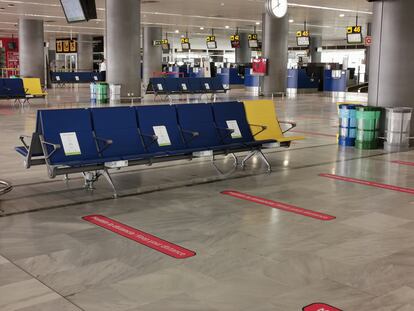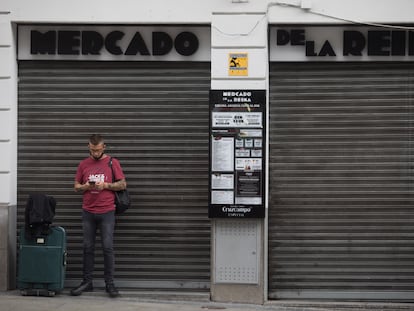Spanish airports see 75% drop in passengers over summer due to coronavirus crisis
Quarantine measures required for visitors to Spain, combined with fear of contagion, have led to a record fall in flight arrivals

Spanish airports recorded their worst summer season this year due to the impact of the coronavirus pandemic and the restrictions placed on travel to Spain. The number of air passengers that passed through the national airport network between July and September – including both months – was 21.4 million, a 75% fall on the same period in 2019, according to figures from Spain’s Aena airport authority.
To put the magnitude of the fall in context, there were more passengers recorded in each of the summer months last year than the entire quarter in 2020. In other words, nearly 30 million travelers arrived in July and August, while 27 million were registered in September.
Another worrying factor is that air traffic is on a downward trend. While there were promising signs of recovery at the beginning of summer, this was cut short when several nations introduced quarantines and other restrictions on travelers who visited Spain due to the high incidence of the coronavirus in the country. The impact was considerable given that Germany and the United Kingdom, which provide the largest sources of tourists to Spain, were among the countries that applied restrictions.
There were more passengers recorded in each of the summer months last year than the entire quarter in 2020
Air traffic fell 76.7% in July, with respect to the same month in 2019, and recovered slightly in August, dropping 69.6% compared to the same period from last year. But this uptick was short-lived: in September, the figure plummeted 79.9%, with just 5.45 million passengers recorded. The drop coincided with a rise in coronavirus cases in Spain, which has already entered a second wave of the pandemic. Amid fear of contagion, the number of international visitors to Spain fell nearly 90% in September, with just 1.95 million registered.
And it’s not just passenger numbers that fell; occupancy on planes also dropped. The number of flights in September fell by only 50.9%, meaning that scheduled flights have been arriving emptier – an issue that is hurting airlines’ profits. Freight transportation, meanwhile, dropped 23.1% upon last year’s figures, with 71,369 tons recorded.
The Madrid-Barajas Adolfo Suárez airport in the Spanish capital received the highest number of passengers in Spain, with 985,077 arriving in September. This represents a fall of 82.3% with respect to the same month in 2019. The airport with the next-highest number of arrivals was Barcelona-El Prat, with 844,414 (-83.5%); followed by Palma de Mallorca, with 513,086 (-86.4%); Málaga-Costa del Sol, with 377,312 (-81.9%); Gran Canaria, with 295,825 (-70%); North Tenerife-Ciudad de La Laguna, with 277,608 (-46.3%); and Ibiza, with 275,016 (-76%).
The outlook for air traffic in October is not much more promising. Last Friday, the Spanish government decreed a state of alarm in the Madrid region in a bid to slow the spread of the coronavirus. Under the emergency measure, nine cities – including the Spanish capital – were placed under a perimetral lockdown, which has restricted the movement of more than five million people. This has led to an additional fall in national air passengers, compounding the drop in international visitors.
English version by Melissa Kitson.
Tu suscripción se está usando en otro dispositivo
¿Quieres añadir otro usuario a tu suscripción?
Si continúas leyendo en este dispositivo, no se podrá leer en el otro.
FlechaTu suscripción se está usando en otro dispositivo y solo puedes acceder a EL PAÍS desde un dispositivo a la vez.
Si quieres compartir tu cuenta, cambia tu suscripción a la modalidad Premium, así podrás añadir otro usuario. Cada uno accederá con su propia cuenta de email, lo que os permitirá personalizar vuestra experiencia en EL PAÍS.
¿Tienes una suscripción de empresa? Accede aquí para contratar más cuentas.
En el caso de no saber quién está usando tu cuenta, te recomendamos cambiar tu contraseña aquí.
Si decides continuar compartiendo tu cuenta, este mensaje se mostrará en tu dispositivo y en el de la otra persona que está usando tu cuenta de forma indefinida, afectando a tu experiencia de lectura. Puedes consultar aquí los términos y condiciones de la suscripción digital.
More information
Últimas noticias
Most viewed
- Sinaloa Cartel war is taking its toll on Los Chapitos
- Oona Chaplin: ‘I told James Cameron that I was living in a treehouse and starting a permaculture project with a friend’
- Reinhard Genzel, Nobel laureate in physics: ‘One-minute videos will never give you the truth’
- Why the price of coffee has skyrocketed: from Brazilian plantations to specialty coffee houses
- Silver prices are going crazy: This is what’s fueling the rally











































